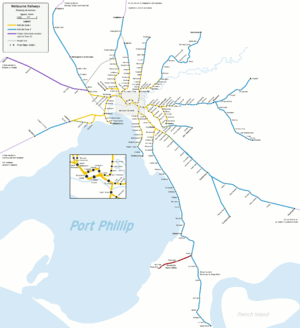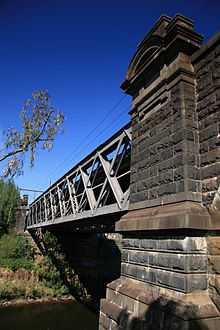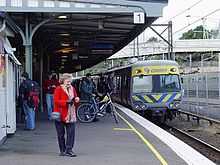Lilydale railway line
| Lilydale railway line, Melbourne | |
|---|---|
 | |
| Line details | |
| Commenced | 1859 |
| Opened | 1860 |
| Completed | 1882 |
| Length | 39.9 km (24.8 mi) |
| Stations | 21 |
| Tracks |
4 (Richmond – Burnley) 3 (Burnley – Box Hill) 2 (Box Hill – Mooroolbark) 1 (Mooroolbark – Lilydale) |
| Used by | Metro Trains Melbourne |
| Service pattern | Stopping all stations except East Richmond, shoulder-peak and peak hour expresses between Richmond and Box Hill, with most trains making intermediate stops at Glenferrie and Camberwell. Short runs on the line to Blackburn in peak periods mostly stop all stations. |
| Rolling stock | Comeng, X'Trapolis |
| Connections | Glen Waverley, Alamein and Belgrave lines |
| Former connections | Outer Circle and Kew lines |
| Railways in Melbourne | |

The Lilydale railway line is a suburban electric railway in Melbourne, Australia. It branches from the Frankston, Pakenham, Cranbourne, and Sandringham lines at Richmond station. It has 21 stations, in Metlink ticketing Zones 1 & 2.
Description
The Lilydale line runs through Melbourne's eastern suburbs across mostly gentle hills (but with some steeper sections near the end of the line), having few straight or level sections. Earthworks are significant, with deep cuttings at Hawthorn, Camberwell, Box Hill, Heatherdale and near Croydon. Around Glenferrie and Auburn the line has been raised above the surrounding area on an embankment to avoid level crossings of several roads. All but two level crossings have been eliminated between the city and Blackburn (Union Road and Mont Albert Road in Surrey Hills). In 2010 a grade separation removed the level crossing at Springvale Road, previously a major bottleneck. Beginning at Blackburn, numerous level crossings still remain.
From Blackburn to Ringwood, there are level crossings at Blackburn Road, Rooks Road, Mitcham Road and Heatherdale Road, most within 200 metres (220 yd) of the Maroondah Highway. This means that many major north/southbound thoroughfares over nearly an 8-kilometre (5 mi) distance become very slow during peak hour services, repeatedly being stopped for passing trains, and also for trains waiting at the nearby stations. Of five rail bridges between Blackburn and Ringwood, three of them are residential streets (Laburnum Street in Blackburn, Cochrane Street in Mitcham and New Street, Ringwood).
Infrastructure
From near Richmond, there are four tracks to Burnley where the Glen Waverley line branches off. From Burnley, the line is triplicated to Box Hill then duplicated to Mooroolbark, while the final section between Mooroolbark and Lilydale is single track. After Lilydale station is a closed railway line that extends to Healesville.
Automatic Block Signalling applies throughout the line. The centre track on the triple-track section is signalled for bidirectional operation and is used for up trains in the morning and down trains at other times.
Terminating facilities are provided at Burnley (although inconvenient and not normally used), Camberwell, Box Hill, Blackburn, Mitcham, Ringwood and Mooroolbark, as well as Lilydale. Stabling facilities are provided at Burnley (adjacent to the Glen Waverley branch), Camberwell, Ringwood and Lilydale.
History
The line from Richmond to Hawthorn was opened initially to a temporary terminus at Pic Nic, just short of the Yarra River, in September 1860, and to Hawthorn in April 1861. It was extended to Camberwell in April 1882, then to Lilydale on the first day of December of that year.
Duplication from East Richmond to Hawthorn occurred about a week after the Lilydale extension opened, and a fortnight (two weeks) later, the same section was converted to Double Line Block Telegraph safeworking, and the section from Hawthorn to Camberwell had Staff and Ticket working implemented.
In May 1885, Hawthorn to Camberwell was duplicated and converted to Double Line Block Telegraph. Duplication was extended to Box Hill in December 1888.
Automatic signalling was introduced from December 1907 with the conversion of the section from East Richmond to Hawthorn to semi-automatic signalling, followed by Richmond to East Richmond being converted to automatic signalling in August 1919, East Richmond to Camberwell in two stages both in October 1922, and Camberwell to Canterbury the following month.
Electrification took place between Flinders Street and Box Hill in December 1922, and extended to Ringwood the following month, then Croydon in November 1925 and finally to Lilydale in October 1925.
Conversion to automatic signalling resumed in April 1927 with the conversion of Canterbury to Surrey Hills, followed by Surrey Hills to Box Hill in October 1929.
The section from Croydon to Mooroolbark was duplicated in 1957, creating a long passing loop on this otherwise single-line section beyond Ringwood. The section from Mooroolbark to Lilydale remains a single track.
Automatic signalling conversions resumed in July 1958 with the section from Box Hill to Blackburn, followed by Mitcham to Ringwood in September of that year, and Blackburn to Mitcham in November 1960.
Hawthorn to Camberwell was triplicated in December 1963, and the triplication was extended to East Camberwell in November 1964. Richmond to Burnley was quadruplicated in 1966/67, and triplication was extended to Box Hill in December 1971, followed by Burnley to Hawthorn in August 1972. This left a short section of double track on the up side of Richmond, but this was quadruplicated with the construction of a flyover in 1973.
Ringwood to Croydon was converted to automatic signalling in November 1973 and duplicated in June 1984. Mooroolbark to Lilydale was converted to automatic signalling in June 1985.
Services
Weekday off peak services stop all stations except East Richmond. Shoulder-peak and peak hour services often run express between Richmond and Box Hill, with most making stops at Glenferrie and Camberwell stations, and some stopping at Surrey Hills station. A select number of peak hour services also run as express trains beyond Box Hill, running express between Box Hill, Blackburn, Mitcham and Ringwood.
Peak hour express trains are supplemented by Alamein line services stopping all stations between Richmond and Camberwell, as well as all stations short runs to Blackburn, with a select number of these services skipping East Richmond.
Weekend services on the Lilydale line run direct from Richmond to Flinders Street and then commence outbound journeys via the City Loop, stopping all stations to Lilydale except Flagstaff and East Richmond.
Line guide
Bold stations are termini, where some train services terminate; italic stations are staffed; and stations with an asterisk (*) are manned only during morning peak.
Branches from the City Loop at Flinders Street and Parliament.
| Lilydale railway line | |||||||||||||||||||||||||||||||||||||||||||||||||||||||||||||||||||||||||||||||||||||||||||||||||||||||||||||||||||||||||||||||||||||||||||||||||||||||||||||||||||||||||||||||||||||||||||||||||||||||||||||||||||||||||||||||||||||||||||||||||||||||||||||||||||||||||||||||||||||||||||||||||||||||
|---|---|---|---|---|---|---|---|---|---|---|---|---|---|---|---|---|---|---|---|---|---|---|---|---|---|---|---|---|---|---|---|---|---|---|---|---|---|---|---|---|---|---|---|---|---|---|---|---|---|---|---|---|---|---|---|---|---|---|---|---|---|---|---|---|---|---|---|---|---|---|---|---|---|---|---|---|---|---|---|---|---|---|---|---|---|---|---|---|---|---|---|---|---|---|---|---|---|---|---|---|---|---|---|---|---|---|---|---|---|---|---|---|---|---|---|---|---|---|---|---|---|---|---|---|---|---|---|---|---|---|---|---|---|---|---|---|---|---|---|---|---|---|---|---|---|---|---|---|---|---|---|---|---|---|---|---|---|---|---|---|---|---|---|---|---|---|---|---|---|---|---|---|---|---|---|---|---|---|---|---|---|---|---|---|---|---|---|---|---|---|---|---|---|---|---|---|---|---|---|---|---|---|---|---|---|---|---|---|---|---|---|---|---|---|---|---|---|---|---|---|---|---|---|---|---|---|---|---|---|---|---|---|---|---|---|---|---|---|---|---|---|---|---|---|---|---|---|---|---|---|---|---|---|---|---|---|---|---|---|---|---|---|---|---|---|---|---|---|---|---|---|---|---|---|---|---|---|---|---|---|---|---|---|---|---|---|---|---|---|---|---|---|---|---|---|
Legend
| |||||||||||||||||||||||||||||||||||||||||||||||||||||||||||||||||||||||||||||||||||||||||||||||||||||||||||||||||||||||||||||||||||||||||||||||||||||||||||||||||||||||||||||||||||||||||||||||||||||||||||||||||||||||||||||||||||||||||||||||||||||||||||||||||||||||||||||||||||||||||||||||||||||||
There were proposals for a station between Lilydale and Mooroolbark near the intersection of Hull and Mooroolbark roads, it has been finalised that the station will not be built.
Further reading
- Fiddian, Marc. Commuters, Shoppers and Scholars - A History of the Melbourne - Lilydale Railway. Pakenham Gazette. ISBN 0-9596316-7-4.
External links
- Statistics and detailed schematic map at the VicSig enthusiast website
| ||||||||||||||||||||||||||||||||||||||
